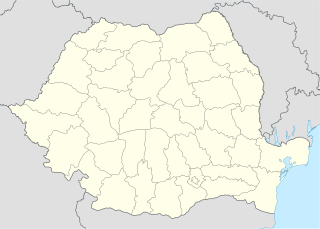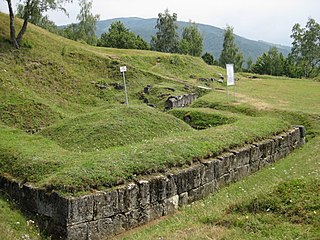
Sarmizegetusa Regia, also Sarmisegetusa, Sarmisegethusa, Sarmisegethuza, Ζαρμιζεγεθούσα (Zarmizegethoúsa) or Ζερμιζεγεθούση (Zermizegethoúsē), was the capital and the most important military, religious and political centre of the Dacians prior to the wars with the Roman Empire. Erected on top of a 1200 m high mountain, the fortress, comprising six citadels, was the core of a strategic defensive system in the Orăştie Mountains.

Dacian Julien Cioloș is a Romanian agronomist who was Prime Minister of Romania between November 2015 and January 2017. In the Călin Popescu-Tăriceanu cabinet, he was Agriculture Minister from October 2007 to December 2008. In November 2009, European Commission President José Manuel Barroso nominated him to be the next Agriculture Commissioner, a post he assumed in February 2010 and held until his term expired in November 2014. In November 2015, President Klaus Iohannis named him Prime Minister, and Cioloș assumed office after receiving approval from Parliament. He remained until after the 2016 parliamentary election, which was lost by the parties that called for Cioloș to continue his term. Cioloș is the founder and current leader of the Freedom, Unity and Solidarity Party. In May 2019, he was elected a Member of the European Parliament, subsequently becoming leader of the new Renew Europe political group.

It was a Dacian fortified town.

Dacian fortress of Bănița is one of the six Dacian Fortresses of the Orăștie Mountains, in Romania. Together with the other Dacian fortresses in the area, it was designated as an UNESCO World Heritage Site in 1999.

The Dacian fortress of Ardan was a Dacian fortified town.

The Dacian fortress of Marca was a Dacian fortified town.

The Dacian Fortress of Breaza was a Dacian fortified town.

It was a Dacian fortified town.

The Dacian fortress of Covasna served as a Dacian fortified town and is rated to have been built in the 1st century BC. It sits on a mountain in the Orăștie Mountains above the town of Covasna, which is 227 km from the capital of Bucharest. The fortress is also known by the name of the Fairies Fortress, sitting atop of the Valley of Fairies.

It was a Dacian fortified town.

It was a Dacian fortified town.

The Dacian fortress of Sânzieni was a Dacian fortified town. It was located in the town of Sânzieni, Romania.

It was a Dacian fortified town.

Feţele Albe is a Dacian fortified settlement on the southern side of Muncelului Hill, situated north of Sarmizegetusa Regia, separated from it by a sharp declivity. Along with numerous walls and resulting terraces, the site contained a sanctuary with circular stone pillars on the third terrace. The settlement was destroyed during the First Dacian War, rebuilt and again destroyed by fire by Trajan's army during the Second Dacian War in 106 CE. The Romans then built a military camp (castrum) on the site.

The Costești-Cetățuie Dacian fortress was a Dacian fortified town. Located near Costești village, Hunedoara County, Romania, it belongs to the Dacian Fortresses of the Orăștie Mountains World Heritage Site. The fortress was built in the 1st century BC, during Burebista’s rule, with the purpose of defending the area against the Romans.

Piatra Roşie, which means Red Rock, was a Dacian hill fort two days march to the west from Costeşti-Cetăţuie fortress, at Luncani in Boşorod municipality. It was built in two phases. In the first phase a long rectangular main citadel was built at the height of land with watch towers on each end and two outlying watch towers. Later the larger area inside the watch towers was enclosed with walls. It appears that the hilltop was flattened in the process in order to produce a usable space.

The Dacian fortress of Racoș was a Dacian fortified town in Romania.

It was a Dacian fortified town.

It was a Dacian fortified town.







